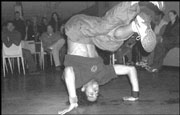LORDS OF THE FLOOR
Sand Point Naval Air Station, Hangar 2 South, 7400 Sand Point Way NE, 783-1600, $10 adv/$12 10 a.m.-6 p.m. Sat., May 12
IT’S MONDAY NIGHT at the Jefferson Community Center and the back room is filled with movement. Bodies are swaying and spinning just the same as in any dance studio—turning is turning, after all, whether you’re on pointe or the top of your head. The break-dancers who practice here are young; many of them are just learning the complicated steps and daring moves that are hallmarks of this recognizably urban dance form. For all the concentration, the room feels a bit chaotic, with people scattered throughout the space. The drill is the same here as it is in any other studio, though: Repetition is the primary tool in dance training.
Feet flash in a complicated sequence over and over, rolling up onto the toes of sneakers only to slam back down on the heels; weight shifts from hands to feet and back again; legs scissor in and out to resolve in a twisted shape balanced fleetingly on one hand. Some of the dancers here tonight are older and more experienced. Right now they’re teaching by example, mentoring some of the younger performers, but later in the evening they’ll work out for themselves, dancing in clubs that underage kids aren’t supposed to get into. They express themselves through these movements, but they can also serve as a form of competition—announcing their status and issuing challenges. Whether informally in a club or more overtly in an organized contest, each dance can be seen as a match—the dancers staking themselves and their reputations on their floor skills.
If break-dancers resemble warriors, in some ways break-dance competitions, like the upcoming Lords of the Floor, resemble sports tournaments more closely than dance performances. With an elimination structure that winnows 64 two-person crews down to a final group of eight, Lords of the Floor co-producer Bob Foxhoven compares the event to the NCAA basketball finals. Those remaining eight will go up against a collection of break-dancing masters—performers who’ve been invited from some of the top crews in the country, including two Seattle groups, Circle of Fire and Massive Monkeys. Judges include Ken Swift from the legendary Rocksteady crew in New York, one of the oldest and most influential groups in the history of break dancing.
ALTHOUGH THIS IS one of the first times such a large event has been staged in Seattle, local groups have already made a mark on the international scene. Circle of Fire and Massive Monkeys have placed first or second in competitions from Hanover, Germany, to L.A., but they’re practically unknown at home, outside of their own community. Lords of the Floor will be a chance for them to shine here, along with local MC Wordsayer from Sources of Labor, and DJs DV-One and E-Rok of the Spinnovators.
Most break dancing we see in the media comes in bits and pieces, as filler in music videos or advertisements, but, in its full form, it’s much more like a long-running drama. Individuals step out from the group to dance a kind of statement, sometimes with a prepared sequence and other times improvising off of a phrase they’ve just seen, and then return to the ensemble, leaving the center of the circle for the next dancer. Comments shift back and forth, dares are made and answered, questions are asked and jokes are told—all within the context of movement. The two-person format in Lords of the Floor will shift the emphasis toward the most difficult combinations of movements, but these conversations will still be there. As they freeze and fly, these dancers will be taking virtuosity to a new and powerful level.








